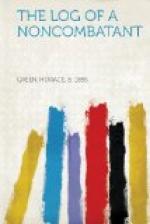Next to Berchem, the southern quarter of the city, where the Germans were approaching, the Rue de Peage was the worst spot in Antwerp. We sat for a time listening to the shells. There were here, in addition to Thompson, Edwin Weigel, a Chicago photographer; Edward Eyre Hunt, of “Collier’s Weekly”; and the Dutch Vice-Consul.
We heard the distant resounding Boom ... Boom
... Boom ... ed ...
Boom ... Boom ... Boom.
An interval of perhaps a second’s silence, then a faint moaning, a crescendo wail, the whirr and rush of a snarling, shrieking skyrocket overhead, and a crash, like all the thunders of the universe rolled into one, when the shell struck, followed by the roar of falling brick as a neighboring house came pouring into the street.
“Whee.....wheee.....Hi.....HIOU UIOUW,” we heard. “Whee ... whEEE ... whEEE ... UIOUW ... OUWW ... SSH ... SSHSHHH ... Bang ... Bang!!!!!!”
“Whee.....wheee.....Hi.....HIOUUIOUW,” we heard. “Whee ... whEEE ... whEEE ... UIOUW... OUWW... SSH ... SSHSHHH... Bang... Bang!!!!!!”
I tried to persuade the other fellows to come up to the Queen’s Hotel along the Scheldt waterfront on the northern side of the city, where I was then encamped. It was a safer locality because the Germans had not yet got the range of the northern end of the city. Weigel and Thompson, having to look out for their kodaks and moving-picture paraphernalia, decided to wait a while, as did Hunt. Hare, who came in later, had two big kodaks which he wanted to get back to his room in the Queen’s. I offered to carry one of them for him.
We shook hands all around and one or two of us exchanged messages to be taken back in case there was any trouble—that is to say, in case, as seemed likely at the time, some of us should get out alive and some should not. Hunt gave me a letter to his family, and later, with watch in hand, started to walk around the burning city to calculate the number of falling shells per minute! I slung Hare’s kodak over my shoulder and we started back, taking separate streets. It was a dash of three quarters of a mile and nothing fell particularly close to us, although the buildings on all sides were in flames. Near a pile of discarded uniforms of the garde civique, I saw what was left of the figure of a man with his insides oozing out, his eyes still open, staring vacantly upwards, and all around him the horrible odor of decaying horses. By this time I was calm and was getting quite accustomed to the bursting of shells. I suppose I had been through my “baptism of fire.”
About half an hour later, when we were sitting in the Queen’s, Thompson, pale as a sheet, staggered into the deserted lobby closely followed by Weigel and Hunt and the Dutch Vice-Consul, the latter somewhat out of his head. Just after I left 74 Rue de Peage, a 32 cm. shell burst on the roof, tearing off the two top floors of the house, throwing Thompson’s bed into the street, and setting the place on fire. At sundown the house was in ashes. Somehow or other the men all got out, rescuing a portion of their paraphernalia.




